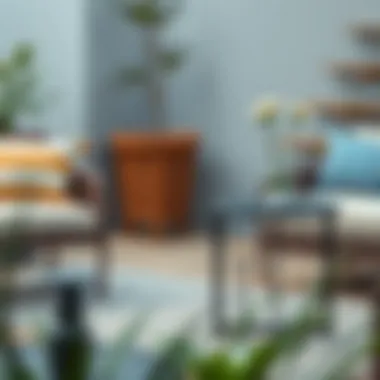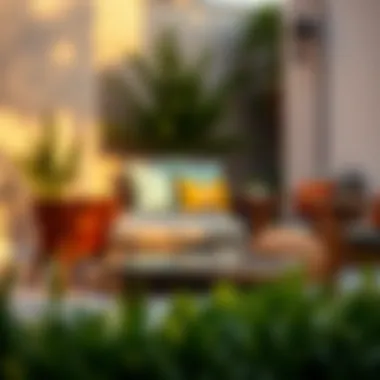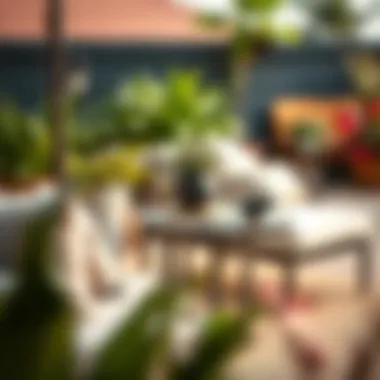Exploring the Versatility of Patio End Tables


Intro
Patio end tables serve a dual purpose: they enhance the aesthetics of outdoor spaces while providing practical solutions for everyday needs. Their versatility goes beyond mere functionality; these tables can transform a sparse patio into an inviting gathering spot. With a variety of styles, colors, and materials available, homeowners can craft a chic outdoor oasis tailored to their tastes.
As you contemplate your outdoor decor, consider how these small yet mighty pieces fit into the bigger picture. Whether you are a homeowner looking to spruce up your patio or a designer curating an outdoor setting, understanding trends and materials will be integral to your success. This exploration of patio end tables will delve into the latest design trends, material considerations, and practical tips to ensure you choose the perfect piece that elevates your outdoor living experience.
By the end of this article, you’ll be equipped with knowledge to select end tables that complement your style and serve your needs, creating a harmonious connection between the indoors and outdoors.
The Importance of Patio End Tables
Patio end tables are often overlooked pieces of outdoor furniture that play a crucial role in enhancing any outdoor living space. These tables are not merely decorative elements; they serve multiple valuable functions that cater to both utility and aesthetics. Their presence can significantly transform the dynamics of patios, balconies, or gardens.
Functional Utility Beyond Aesthetics
When we delve into the importance of patio end tables, one of the compelling aspects that stand out is their functional utility. They provide a convenient surface for placing drinks, books, or decorative items.
Imagine sinking into a comfortable chair on a warm afternoon, with a refreshing beverage at arm's reach. That's where these tables shine, allowing for effortless access to your essentials.
Some key functionalities of patio end tables include:
- Additional Storage: Many models come with features like shelves or drawers, offering extra storage space for small items like coasters, snacks, or even gardening tools.
- Multi-Purpose Use: These tables can be used during outdoor parties as serving stations for appetizers or as side tables for games and activities. Their versatility allows them to be used in various scenarios, be it a casual gathering or a serene moment alone.
In truth, patio end tables unite comfort with convenience, making them invaluable in ensuring a cohesive outdoor experience.
Enhancing Outdoor Comfort and Convenience
Patio end tables also enhance the overall comfort and convenience of an outdoor area. Without them, an open space can feel incomplete and less welcoming. They encourage social interactions and ease the flow of activity.
- Create a Welcoming Atmosphere: The right patio end table can bridge the gap between seating arrangements, creating defined spaces for interaction without enclosing them too tightly.
- Encouraging Relaxation: By having a steady surface to rest a book or a plate, you can spend more time unwinding with family and friends.
Moreover, patio end tables aren’t just about fitting into a layout; they also add character. They can be a focal point that reflects your personal style, be it through color, shape, or material, showcasing a blend of personality and practicality.
Having the right kind of table in your outdoor setting goes a long way toward achieving that ideal balance between comfort and functionality. Their role in making outdoor living spaces truly livable cannot be understated.
"Patio end tables are small but mighty — they enhance comfort and promote a lifestyle of ease and enjoyment."
In sum, patio end tables establish a foundation for our outdoor spaces, enriching our overall experience while simultaneously adding a touch of charm.
Design Considerations for Patio End Tables
When you think about decorating your outdoor space, it's easy to get carried away with styles and colors of cushions and pillows. However, the design of patio end tables should not be an afterthought. These tables are more than just decorative elements; they shape the functionality and overall aesthetic of your outdoor experience. When approaching the design of a patio end table, several key considerations come into play that enhance both the utility and visual appeal of these pieces.
Style and Aesthetic Integration
Integrating style into the design of patio end tables means finding a balance between functionality and your outdoor decor's visual language. Different styles can greatly affect the vibe of your outdoor area. For instance, a rustic wood table might conjure feelings of a cozy cabin retreat, whereas a sleek metal table could bring a modern flair to your patio. Here are a few points to consider:
- Color Palette: Choose colors that complement your existing furniture and surroundings. Neutral tones suit a serene ambiance, while vibrant hues can add energy.
- Complementing Styles: If your patio is adorned with Mediterranean-themed décor, opt for end tables with ornate detailing. Alternatively, keep it minimalist for mid-century modern setups.
- Materials Matching: The material of the end table should harmonize with the other furniture on your patio. If you have wicker seating, for example, a wicker end table can create a pleasing continuity.


By prioritizing style and aesthetic integration, you not only enhance the beauty of your outdoor space but also create a cohesive look that reflects your identity.
Size and Scale in Context
The scale and size of patio end tables can be a stumbling block if not thought through carefully. You wouldn’t want an imposing table dwarfing a set of delicate chairs, nor would a tiny table suit a sprawling sectional. Here’s what to keep in mind:
- Proportionality: Ensure that your end table matches the height and scale of your seating. A good rule of thumb is that the table top should be level with the seat height.
- Space Considerations: Measure the available space before making a commitment. If your patio area is cramped, choose slender tables that provide utility without overwhelming the space.
- Multi-functionality: In limited spaces, select tables that can serve varied purposes, like stacking or nesting tables. These designs provide flexibility and can be repositioned as needed.
Ultimately, paying careful attention to size and scale in context ensures that your patio end tables won't just sit idly by but rather actively contribute to a harmonious atmosphere.
"Design is not just what it looks like and feels like. Design is how it works." - Steve Jobs
The careful consideration of design elements is foundational to creating an inviting and functional outdoor space. As you integrate style and size into your patio end table selection, you set the stage for an enjoyable outdoor experience, combining beauty with practicality.
For more inspiration on integrating design elements into your outdoor spaces, consider visiting Wikipedia or Britannica.
Whether you’re a designer looking to enhance client spaces or a homeowner planning your backyard, revisiting these design considerations will serve you well.
Materials Used in Patio End Tables
When it comes to patio end tables, the materials selected can greatly influence their functionality, style, and durability. Choosing the right material not only enhances the aesthetic appeal of an outdoor space but also ensures longevity and ease of maintenance. This section delves into the primary materials used in patio end tables, exploring their unique characteristics, advantages, and considerations.
Wood: Timeless Elegance and Natural Charm
Wood is often revered for its natural beauty and timeless appeal. The warmth of wood adds a touch of elegance to any patio. Hardwoods, such as teak and mahogany, are particularly sought after for their resistance to rot and insects. Choosing solid wood end tables may set you back a few bucks, yet their durability often justifies the expense.
- Benefits of Wood:
- Aesthetics: Wood offers an organic look that blends seamlessly with garden settings.
- Strength: High-quality wood can withstand significant weight and weather conditions.
- Sustainability: Sustainably sourced wood options support eco-friendly practices.
Be aware, though, that wood does require maintenance. Regular sealing or staining helps preserve its appearance, preventing warping and cracking from moisture exposure.
Metal: Durability Meets Modern Design
Metal is another popular choice for outdoor table materials, particularly aluminum and wrought iron. While wood may ooze charm, metal brings a certain edge with sleek designs that suit contemporary decor.
- Advantages of Metal:
- Durability: Metal tables typically resist fading and can withstand harsh weather, including rain or harsh sunlight.
- Variety: They come in many shapes, sizes, and finishes—nice for matching various decor styles.
- Low Maintenance: A simple wipe-down with a cloth is usually enough to keep them looking shiny.
However, rust can be a concern with some metals, so ensure you choose rust-resistant materials or coats.
Resin and Plastic: Practical Solutions for Outdoor Use
For those seeking affordability paired with practicality, resin and plastic end tables are the go-to options. These materials are often light, making them easily movable around your patio or garden. They are designed to mimic the look of wood or metal, providing the texture and appearance of high-end materials without the hefty price tag.
- Key Points on Resin and Plastic:


- Affordability: Typically cheaper than wood or metal options.
- Weather Resistance: They resist fading from UV rays and can withstand moisture without warping.
- Variety of Designs: Available in multiple shapes and colors, allowing for vibrant patio designs.
Yet, it’s wise to note that while these materials are durable, their aesthetic appeal may not align with everyone’s vision of elegance.
For further insights, one might explore resources such as Wikipedias on furniture types, or design examples on Houzz.
Current Trends in Patio End Table Design
Current trends in patio end table design play a significant role in how these versatile pieces enhance outdoor living spaces. With an increasing emphasis on aesthetics, functionality, and sustainability, understanding these trends ensures that homeowners, designers, and retailers stay ahead of the curve in providing a cohesive and stylish outdoor environment. Moreover, recognizing what is currently popular in design allows for better purchasing decisions, aligning with the overall theme of home decor.
Minimalist Approaches for Clean Lines
Minimalism has taken the design world by storm, and patio end tables are no exception. The essence of this trend lies in simplicity and functionality. Clean lines, a thoughtful selection of materials, and an overall uncluttered look characterize minimalist end tables. These pieces often feature geometric shapes and subtle colors, making them perfect for any outdoor setting.
When opting for minimalist approaches, consider materials like metal and glass, which complement the aesthetic beautifully. Designs may incorporate wood in a more stripped-back form, which brings forth a touch of nature without a cumbersome appearance. This trend is not just about looks; it’s also about practicality.
Choosing the Right Patio End Table
Selecting the right patio end table is not just about picking a piece of furniture that looks nice. It's about enhancing your outdoor living space, maximizing functionality, and complementing your overall aesthetic. As you navigate through choices, you'll find that a well-selected end table can serve multiple purposes, from holding drinks to showcasing decorative items.
It's essential to carefully consider your needs, the space available, and how the table will integrate into your existing decor. When you get it right, it can elevate the ambiance of your patio and even be a conversation starter for guests.
Assessing Your Outdoor Space
Assessing your outdoor space is the first step in determining which patio end table will work best for you. Take a good look around: how much space do you have? What existing furniture is already in place, and how do those pieces flow together? Look at things like:
- Size: Consider how much room is available for the end table. You want a piece that fits without overwhelming the space or becoming obstructive.
- Layout: Take note of the current layout of your patio. Is it long and narrow or more square? Does it include a grill, lounge chairs, or a dining table? Your end table should slot in seamlessly with existing pieces.
- Usage: Consider what you'll be using the end table for. Is it merely a spot for drinks or will it also serve as a place for snacks, books, or even planters? This can greatly influence your choice.
Create a mental image, or even better, sketch out how you envision the space functioning. Remember that an end table is there to enhance your outdoor experience, so keep that in mind as you assess your environment.
Functionality vs. Aesthetic Preferences
When choosing your patio end table, you often find yourself at a crossroads between functionality and aesthetic preferences. Each aspect holds its own significance, yet it’s essential to find a balance.
- Functionality is key if you'll often be using the table for practical purposes. Think about how it will be used day-to-day. A table with additional storage for outdoor essentials, like coasters or sunscreen, can bring added convenience. Features like folding options or wheels for easy mobility also enhance its utility.
- On the other side of the coin, aesthetic preferences play a crucial role in creating a welcoming and beautiful outdoor environment. Do you prefer sleek modern lines or rustic charm? Will a woven design complement your patio sitting area? Choices should reflect your personal style while still considering the overarching theme of your patio.
When merging functionality with aesthetics, it's crucial. A table can be both attractive and useful. As you make your decision, take everything into account to create an inviting outdoor area that expresses who you are while amplifying how you enjoy your space.
"The right table brings a sense of harmony to your outdoor experience. It's where style meets substance - creating an oasis tailored just for you."
Your patio end table needs to be more than a flat surface; it should complement your lifestyle in enjoyable ways. Balance these two factors as you finalize your decision, ensuring you end up with a piece that checks all the boxes.
Maintenance and Care for Patio End Tables
Taking care of patio end tables is not just about aesthetics; it's paramount for their longevity and functional performance. Each piece of furniture, whether made of wood, metal, or resin, goes through wear and tear due to exposure to the elements and regular usage. Proper maintenance and care can result in years of enjoyment and usability from your outdoor investments. Here, we will explore seasonal maintenance routines and provide cleaning tips that cater to various materials, ensuring that your end tables not only look great but also serve their purpose efficiently.
Seasonal Maintenance Routines


It's no secret that the changes in seasons can wreak havoc on furniture left outside. Each season presents its unique set of challenges, from the scorching sun to rain and snow. Implementing a seasonal maintenance routine can help ward off damage and keep your patio end tables in tip-top shape. Here’s a guide to what you should consider for each season:
- Spring: After a long winter, think about a thorough clean. Dust and debris can accumulate, so a gentle wash with mild soap and water can do wonders. Inspect for any signs of damage that may have occurred during the colder months, such as splintered wood or rusted metal joints.
- Summer: With increased use, it’s wise to check for any fading caused by UV rays. Applying a protective sealant for wood tables or a rust-resistant spray for metal can help prolong their life. Don't forget to wipe off grime regularly to maintain appearance.
- Fall: As leaves begin to fall, it’s essential to keep tables free from debris to avoid staining and moisture buildup. Consider using covers designed for outdoor furniture to protect against both leaves and moisture as temperatures drop.
- Winter: If possible, store your tables indoors or at least cover them securely with weather-resistant tarps. Bringing wood furniture inside can prevent cracking from freezing temperatures. If they must stay outside, it's important to ensure they remain dry and covered.
A structured maintenance routine as described not only preserves the beauty of the tables but also their functionality over the years.
Cleaning Tips for Various Materials
Understanding the correct way to clean patio end tables based on their material is vital for maintaining their integrity without causing damage.
- Wood: To clean wooden end tables, start with a soft brush or a damp cloth to remove visible dirt. For a deeper clean, mix equal parts vinegar and water, and gently scrub the surface. Ensure you dry it immediately to prevent warping. Occasionally, apply a high-quality teak oil to restore moisture and protection.
- Metal: Metal tables can be prone to rust, so regular cleaning is important. A simple solution of soap and water often suffices. If rust has set in, use steel wool to gently scrub off the rust spots, followed by a metal primer and paint to protect any damaged areas.
- Resin and Plastic: These materials are generally low maintenance. A soft cloth soaked in soapy water will effectively handle most dirt. For stubborn stains, a mixture of baking soda and water can work wonders. Rinse well to avoid soap residue. Resin and plastic tables can withstand the elements, but a quick wash every now and then doesn’t hurt.
Keeping your end tables in pristine condition only adds value to your outdoor space, ensuring they remain a functional part of your garden or patio scenery for years to come.
Integrating Patio End Tables into Outdoor Lifestyle
Integrating patio end tables into your outdoor lifestyle can transform your space from a simple area of relaxation to a dynamic and inviting extension of your home. These tables do more than just hold drinks and snacks; they become central pieces around which social interactions bloom. When you think about creating that ideal outdoor escape, patio end tables serve as essential anchors. They bring together various elements like seating arrangements, lighting, and decor, crafting a cohesive and functional layout.
Creating Cohesive Layouts
When it comes to outdoor aesthetics, how the furniture is arranged is critical. A well-thought-out layout enhances the use of space, making sure everything feels balanced and harmonious. Patio end tables play a key role in this aspect. Here are a few tips for achieving a cohesive layout:
- Consider Proximity: Place end tables where they are most needed. For instance, next to seating areas to ensure easy access to drinks and snacks.
- Maintain Flow: Ensure enough space around the tables to facilitate movement. A cramped space can be a downer when hosting guests.
- Group Elements: Pair end tables with your seating arrangement. A well-placed table next to a lounge chair can make a perfectly relaxing corner where one could sit back with a book.
- Balance Sizes and Heights: Mixing different sizes of tables and varying heights can add visual interest. A tall table beside a low seating arrangement can create an engaging contrast, drawing the eye naturally across the area.
Emphasizing these principles in your outdoor layout not only maximizes functionality but also enhances the overall ambiance of your patio.
Accessorizing with Textiles and Decor
Accessorizing patio end tables can elevate the outdoor experience significantly. Textiles and decorative elements can make the space feel more inviting and comfortable. Here are several ways to infuse character into your layout:
- Use Textiles Wisely: Outdoor cushions, throws, or table runners can add color and texture. These soft elements not only make the seating more cozy but also provide an extra dose of style.
- Incorporate Planters: Adding some greenery, through small planters or potted plants, elevates the tables while making the environment feel more lively. Consider herbs or blossoms that thrive outdoors.
- Lighting Elements: Incorporating battery-operated lanterns or solar-powered lights on an end table can create an enchanting evening atmosphere. The sparkle of light amidst natural surroundings enhances a magical feel.
- Personal Touches: Think of small sculptures, photo frames, or decorative bowls. These personal items can spark conversations and make your patio uniquely yours.
By combining thoughtful layouts with curated decor, patio end tables become not just functional pieces but integral parts of the outdoor lifestyle experience. They embody relaxation, conversation, and personal expression, ensuring that your outdoor area feels as lovely as the inside of your home.
The Role of Customization in Patio End Tables
Customization plays a pivotal role in defining the unique character and functionality of patio end tables. For homeowners and designers alike, the importance of tailoring these pieces to meet specific needs cannot be overstated. A patio end table is more than just a surface; it serves as a reflection of personality, lifestyle, and the overall aesthetic of the outdoor living area.
Tailoring Designs to Personal Preference
Patio end tables come in diverse styles and sizes, allowing individuals to express their unique taste. From rustic wooden tables to sleek metal designs, personalization offers homeowners the wealth of options needed to capture their vision. Some may prefer minimalist designs that harmonize with the surrounding landscape, while others might opt for colorful or eclectic pieces that stand out as conversation starters.
Further, dimension and form can be customized. For instance, if a space feels cramped, custom tables can be made with narrower profiles or unusual shapes that fit snugly in challenging spots, yet still serve their purpose effectively. Crafted to personal preferences, these tables contribute greatly to both functionality and ambiance. It is essential for designers to engage with clients when discussing customization options. By utilizing fabric swatches, color palettes, and even layout sketches, designers can help facilitate informed decisions.
Innovative Custom Solutions
Innovation is the name of the game in the realm of patio furniture, and end tables are no exception. Customization nowadays goes beyond mere aesthetic choices. Contemporary manufacturers are embracing technology and new materials, resulting in innovative solutions that adapt to various lifestyles.
For example, modular patio end tables allow users to combine different sections to create an arrangement that fits their outdoor living experience. The ability to reconfigure furniture as needed is a boon for both families who often entertain and individuals who enjoy changing their outdoor setup. Additionally, integrated features such as built-in coolers or charging ports cater to modern needs, enhancing convenience and usability of outdoor tables.
Moreover, sustainable practices in customization, such as sourcing eco-friendly materials, resonate deeply with today’s environmentally conscious consumers. Features like repurposed wood or recycled metals are increasingly popular, appealing to those who seek to minimize their ecological footprint without sacrificing style.
Customization is not just about looks; it is about creating a functional masterpiece that fits seamlessly into the user’s lifestyle.
Overall, the realm of patio end tables is ripe with opportunities for customization. Whether through personal preferences or innovative solutions, customized tables hold the potential to transform any outdoor space into a personal oasis, tailored to specific tastes and functional needs.















